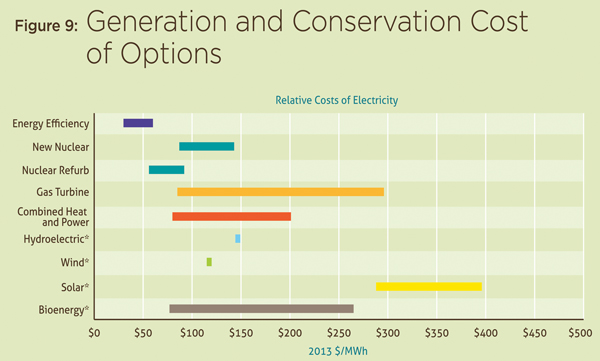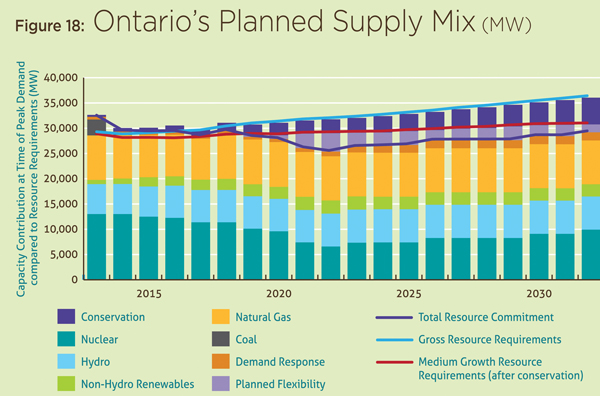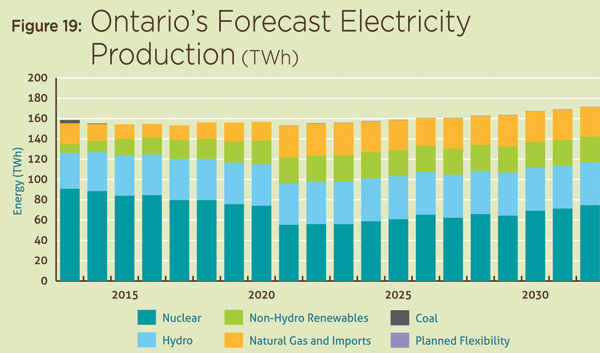The Ontario government released its updated Long Term Energy Plan (LTEP) on December 2, immediately attracting comments both positive and negative, and opening up questions about how the public discussion and the plan itself are likely to move forward. The document sets out in general terms what the provincial government expects to do with respect to generation, transmission and demand management over the next two decades, until 2032.

The plan is more cautious than the previous version released in 2010. The current plan focuses on making a high priority of energy efficiency and conservation, largely in order to reduce the expense associated with building new generation and transmission in the immediate future. Soon after the plan was released, Ontario Energy Minister Bob Chiarelli said, “We believe it’s a balanced approach; it’s a smart approach not to invest billions of dollars into the system that we don’t need.”
In fact, the over-riding theme of the LTEP, to the extent there is one, seems to be to maintain flexibility in the system and avoid making major financial commitments at this stage. Although Ontario’s ambitious green energy targets will continue, it has been slowed down somewhat, presumably in an effort to soften the expected cost increases for consumers. And, as announced a few weeks before the plan’s official release, construction of new nuclear capacity has been put on hold for the time being, although large-scale nuclear refurbishments will go ahead, starting in 2016. The government says deferring two new nuclear units represents a savings of $15 billion for ratepayers in the first few years of the plan.

Media reports focused on the plan’s projections for electricity rates. Under the updated LTEP, the Ministry estimates rates will increase by 2.8% annually over next 20 years (42% by 2018, and 68% by 2032), significantly less than the 3.5% annual increase estimated in the 2010 LTEP. The reduced rate increases result from lower demand forecasts, lower feed-in tariff rates for renewable power, the renegotiation of a large green power deal with Samsung, the deferral of new nuclear build, the introduction of new dispatch rules for some renewables, and conservation efforts. The LTEP document says it balances five principles that will guide future decisions: “cost-effectiveness, reliability, clean energy, community engagement, and an emphasis on conservation and demand management before building new generation.”

APPrO President Dave Butters noted that cost-effective electricity investment in Ontario depends on confidence in a policy environment that is consistent, transparent and fair over a long period. “The LTEP provides a sensible and flexible framework for providing reliable and increasingly clean electricity for Ontario,” he said.
“We are pleased that the government has adopted a number of our recommendations, especially the need to commit to and lay out a timetable for nuclear refurbishments at Bruce and Darlington to provide ongoing supply certainty and system reliability. These clean energy resources are the backbone of our electricity supply and help to keep electricity prices low and stable. We cannot afford any uncertainty regarding their future,” he added.
“APPrO also believes Ontario should get the maximum value from existing electricity resources,” Butters said. For example, the LTEP notes that 75% of the contracts for the 1200 MW of Ontario’s gas-fired legacy Non-Utility Generators (NUGs) expire by the end of 2018. He noted these resources are widely dispersed, already permitted, support local jobs and industries and can readily provide generation needs and attributes over the LTEP horizon, at prices likely lower than new generation. “A Directive was provided to the OPA in 2010 to begin recontracting negotiations with the NUGs, but only one has been completed so far,” he said.
With respect to the provisions for conservation and demand management he noted that, “APPrO supports efforts that help the system operator to manage the grid and ratepayers to be as efficient as they can with their electricity use, but we should also recognize that generation stations are multi-product assets: they can provide a wide array of electricity services, provided there is a level playing field on which to compete”, he said.
Progressive Conservative energy critic Lisa MacLeod said, “We are now the only jurisdiction in the world that thinks an economic downturn is a conservation plan.” New Democrat Leader Andrea Horwath, the leader of the Ontario NDP who supports greater reliance on publicly owned generation, criticized the LTEP as “more of the same blind faith in private power mega-deals that drive up energy costs.”
The plan places great emphasis on local input: “Communities must be allowed to take a more central role when implementing provincial policy objectives. The opportunity for communities to participate in energy infrastructure must be balanced with their responsibility to take ownership of local decisions,” Minister Chiarelli said.
Additional features of the LTEP include the following:
• Ontario is aiming to use Demand Response to meet 10% of peak demand by 2025, equivalent to approximately 2400 MW.
• Ontario has established a long-term conservation target of 30 TWh in 2032. By using programs and improved codes and standards, the province expects to offset almost all of the growth in electricity demand to 2032.
• The IESO is expected to develop new initiatives to meet demand response goals and consult on the development of a capacity market.
• Annual energy reports will be produced, to update the supply and demand conditions, and to outline progress to date on LTEP.
• The target for new non-hydroelectric renewable procurement will be 10,700 MW by 2021 rather than 2018.
• The province’s target for hydroelectricity has been raised by 300 MW to 9300 MW by 2025.
• The Ministry will launch a new large renewables procurement process early in 2014 that will take into account local needs and considerations.
• The OPA will launch a new CHP program targeting agri-food, greenhouses, and district energy.
• The Ministry, the IESO and the OPA will work with municipal partners to ensure early and “meaningful” involvement in energy planning.
• The province will work with gas distributors and municipalities to examine options for expanding natural gas infrastructure within the province, improving access for rural and northern communities.
• Ontario will launch an Aboriginal Transmission Fund early in 2014 to facilitate Aboriginal participation in transmission projects.
• The province will make new financing tools available to consumers starting in 2015, including programs to incent energy efficient retrofits to residential properties.
• The government intends to initiate work on a priority basis to alleviate regulatory barriers to storage. Storage procurement will start in 2014 with procurement of at least 50 MW, and projects that integrate a storage component are to be considered in the new large renewable RFP.
Targets for the new competitive process for procuring large scale renewable energy projects (larger than 500 kW) are set at:
• Wind 300 MW for 2014 and 2015;
• Solar 140 MW for 2014 and 2015;
• Hydro 50 MW for 2014 and 45 MW for 2015;
• Bioenergy 50 MW for 2014 and for 2015.
The plan proposes to examine the potential for developing a capacity market in Ontario, partly as a conservation measure. Jason Chee-Aloy of Power Advisory LLC notes that, “Any development of an Ontario capacity market will need to be clear in its purpose, and may need to address how contracted generation facilities, rate-regulated generation facilities, and contracted DR resources could all participate on a level playing field.”
He also notes that as a result of the refurbishment and life extension risks of the Darlington, Bruce and Pickering generating units, “there could be future scenarios where supply is needed sooner than anticipated in the LTEP and the quantity of required supply could also increase. If these future scenarios were to become reality, we believe that ‘Planned Flexibility’ will become a requirement even more so than what’s projected in the LTEP and will result in procurement of additional gas-fired generation in the form of either new build and/or re-powering existing natural gas-fired and potentially retired coal-fired units (only where re-powering coal-fired units is proven to be cost effective).”
Chee-Aloy’s commentary notes that, “The transmission section within the LTEP has undergone the most changes relative to the 2010 LTEP. The LTEP now places a stronger emphasis on northern transmission projects to accommodate projected increases in electricity demand resulting from mining activities and connection of remote First Nation communities. The 2010 LTEP placed an emphasis on transmission development and upgrades to accommodate increased connection capacity for renewable generation project development.” The previously proposed new West of London transmission line is no longer being planned for development.
“The process of exchanging commentary on the LTEP will quite likely prove to be healthy, stimulating public interest in energy issues,” said APPrO Executive Director Jake Brooks. The province has committed to sustained consultation and engagement. “The plan would likely benefit if responses to it can be directed through organized channels designed to resolve issues and move forward with the plan,” he said. “There is a risk that the plan will be perceived primarily as a political document, overly influenced by short term electoral considerations. While some amount of political input is necessary, primarily in the area of the supply mix, the distinctions between the political and non-political aspects of the plan have declined compared to that of the Integrated Power System Plan previously developed.” Observers will likely study the plan closely to identify which parts can be expected to endure through a potential change of government or government policy.
Chee-Aloy notes that further clarity would be advisable in terms of “what is and what is not mandatory regarding the integration of energy projects within respective plans so as to plan for or support future development of respective energy projects (e.g., what obligations do municipal planners have regarding development of energy plans and/or incorporation of energy projects within municipal plans?).”
In conjunction with the LTEP, the province is launching education initiatives including a project titled “emPOWERme,” a web feature that uses videos, graphics, interactive tools and fact sheets to explain energy basics. Minister Chiarelli has let it be known that he is considering the establishment of an Energy Education Trust, involving key industry players, to assist with energy education and energy literacy.
The government held consultations in 12 different communities to gather public feedback on energy issues in advance of updating the Long-Term Energy Plan. It also met with representatives of over 90 First Nation and Métis communities and organizations in 10 engagement sessions across Ontario. More than 1,000 submissions and comments were received, primarily through the online Environmental Registry, and almost 8,000 people participated in an online survey. The results of the survey are published in Ontario’s Open Data Catalogue.
Chee-Aloy concludes that, “The list of initiatives is plentiful and will present challenges for how the LTEP’s initiatives become operationalized, especially considering likely resource constraints at the OPA (as OPA is being tasked with developing, launching and facilitating several procurement processes). Therefore, priorities of these initiatives need to be better understood and conveyed to all stakeholders in order to provide clarity relating to present and future business opportunities.”
For a copy of the LTEP, various background papers, and information on public education initiatives including emPOWERme, readers may visit the website of the Ontario Ministry of Energy. Detailed analyses of the LTEP have been distributed by Borden Ladner Gervais and Gowlings, and are available from APPrO.
